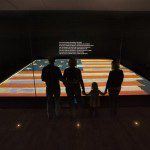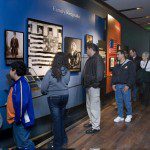“. . . May the heaven-rescued land praise the Power that hath made and preserved us a nation,” wrote Georgetown lawyer Francis Scott Key on Sept. 14, 1814. America had dodged a bullet, bombs bursting in air and the rocket’s red glare 200 years ago.
Key exalted at the sight of the huge American flag, the Star-Spangled Banner, waving at Fort McHenry, Maryland. Unable to pass the fort and attack Baltimore, the British Royal Navy ceased its bombardment and withdrew. Within five months, the War of 1812 was over, and America re-ignited its growth to greatness.
The exaltation of Key and America at the time — which cannot be overestimated — guaranteed Americans’ love of the flag and of the national anthem, “The Star-Spangled Banner.”
For Georgetowners, it is personal — Francis Scott Key was a Georgetowner who left his house and large family on M Street, as instructed by the White House, to negotiate the release of William Beanes, who was held by the British. In meeting with navy officers, Key was detained on a British ship near Fort McHenry, because the bombardment was soon to begin. Key witnessed the pounding and shaking the fort took and Baltimore felt.
The plan was to cut the very young nation in half. Remarkably, it was America that declared war on Britain, seen as preventing westward expansion, blocking trade and harassing on the high seas. The war was not going well. Key, a member of the Georgetown Artillery, commanded by Major George Peter of Tudor Place, was at the Battle of Bladensburg– and later witnessed the burning of Washington in August 1814. The morning of Sept. 14, 1814, shone as an amazing reversal of fortune.
Key’s lyrics for the defense of Fort McHenry, printed in a Baltimore newspaper two days after the September confrontation, “went viral” — to use a 21st-century phrase — up and down the East Coast. Immediately popular, “The Star-Spangled Banner” has never lagged in its ability to move Americans.
That flag from 200 years ago is less than three miles away at the Museum of American History from where Key lived in Georgetown.
While the song can take a beating from anyone who sings it, the flag cannot. The museum embarked on a conservation of the flag in 1998. It finally re-emerged in 2008 in a new display and renovated museum. It is one of those things considered sacred by Americans.
Why is the flag supremely important to Americans? Its image over the decades across the nation and the world, across voyages and wars, can move the toughest of us to tears — it is a unifying force for all Americans. More recently, such energy was felt after the September 11 attacks.
“Two hundred years ago, Francis Scott Key, inspired by the sight of the flag’s ‘broad stripes and bright stars,’ wrote a song that gave new significance to a national symbol and started a tradition through which Americans have invested the flag with their own meaning and memories,” said John L. Gray, director of the museum. “It is an honor for the museum to be the home of the Star-Spangled Banner and to preserve it for future generations.”
To observe the time 200 years ago, when the flag and the song proved one of America’s greatest moments, the museum announced that from Flag Day, June 14, through July 6, “the Maryland Historical Society is lending Francis Scott Key’s original manuscript of the ‘Star-Spangled Banner’ lyrics, uniting it for the first time with the flag Key saw at ‘dawn’s early light.’ Visitors will be able to see the 30-by-34-foot flag and the manuscript, side-by-side in the banner’s environmentally controlled chamber at the museum.”
One of the citizens who helped with the Star-Spangled Banner conservation in a huge way was fashion designer Ralph Lauren. He and his company donated more that $13 million to complete the work on the tattered, fragile flag, which originally measured 30 by 42 feet. Lauren, whose designs are inspired by Americana and the flag, considers the Star-Spangled Banner “our greatest American treasure.”
For his work, the Smithsonian will honor Lauren three days after Flag Day festivities. On June 17, the Smithsonian noted that “it will present designer Ralph Lauren, son of immigrants, with the James Smithson Bicentennial Medal during a naturalization ceremony welcoming 15 new Americans. The medal recognizes Lauren’s lifetime contributions to American artistry, entrepreneurship, creativity and vision. Lauren also played a leadership role in the preservation of the Star-Spangled Banner.”
“I love this country. I love being an American. My earliest memories of the Star-Spangled Banner was the flag that flew from the flagpole in the school across the street from my childhood home in the Bronx where we played baseball and basketball. I remember pledging allegiance to the flag each morning in school. It was a simpler time, after a world war, when those broad stripes and bright stars stood for our homeland and the freedom and hope it brought to every American,” wrote Lauren in the forward to “The Star-Spangled Banner: The Making of an American Icon.” Such enthusiasm for the flag will continue this Flag Day, as the National Museum of American History celebrates the 200th anniversary of the Star-Spangled Banner with “Raise it Up! Anthem for America.”
––According to the museum, “Artists such as Aloe Blacc, Renée Fleming, Angie Johnson and Brian McKnight are encouraging Americans to take part in the museum’s coast-to-coast celebration in a national sing-a-long event for people to come together and sing their anthem at 4 p.m. EDT. Details are at anthemforamerica.si.edu.”
Across America, many groups are coming together for the celebration — the National Park Service, Little League, Girl Scouts and the Kennedy Center. On the museum’s Mall terrace, Grammy-winning composer Eric Whitacre will conducts a 500-person choir in performance of “America the Beautiful;” MacArthur fellow Francisco J. Núñez will conduct “Lift Every Voice,” with commander and conductor Col. Larry Lang directing the U.S. Air Force Band and Singing Sergeants.
To continue this Star-Spangled summer, this newspaper — which helped to start the foundation which completed the Francis Scott Key Park on M Street in 1993 — invites its readers to send impressions of and moments with the flag to Editorial@Georgetowner.com.
There will also be more stories about the events of the summer of 1814, whether it is the British attack on Washington, the story of James and Dolley Madison, the loss of Key’s house on M Street in 1947 and the ultimate meaning of America’s Second War of Independence, which has led to centuries of peace between the U.S., Great Britain and Canada.
We recommend and will review Steve Vogel’s remarkable book, “Through the Perilous Fight: From the Burning of Washington to the Star-Spangled Banner: The Six Weeks That Saved the Nation.”
Meanwhile, appreciate the ultimate fabric from the War of 1812, our flag, and its song — “The Star-Spangled Banner” — ?”Then conquer we must, when our cause it is just, And this be our motto: ‘In God is our trust.’ And the star-spangled banner in triumph shall wave, O’er the land of the free and the home of the brave!”





